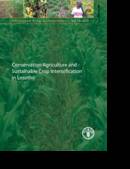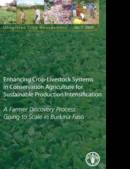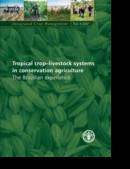Resources

Technical guidelines - Lesotho is a small mountainous country characterized by extensive land degradation and erratic climatic conditions. In recent years a growing number of development agencies have been promoting conservation agriculture (CA) as a means to enhance rural livelihoods through sustainable production intensification. The present case study prepared under the AGP Framework for Sustainable Crop Production Intensification draws on the data collected by FAO in 2006 and illustrates the impact of CA and more specifically the local version of CA, the likoti-system, on sustainable crop intensification in the south-eastern highlands of Qacha’s Nek district and in the western lowlands of Butha-Buthe and Berea. According to these data, the adoption of likoti has brought about...

Technical guidelines - This is a story about how FAO assisted groups of farmers in five farming communities in the moist savanna zone of South Western Burkina Faso to enhance their crop-livestock systems through Conservation Agriculture (CA) practices, including crop diversification, using an innovative farmer discovery process, to bring about agricultural intensification and improvement in livelihoods. FAO’s assistance was delivered largely by working with national institutions, adding value to ongoing stakeholder resources and activities. It is a story of positive intensification outcomes brought about by adapting ‘proven principles and practices’ of CA and crop diversification into existing crop-livestock systems. FAO worked with a range of stakeholders including the farmers and their communities, and the research and...

Technical guidelines - The present publication on Visual Soil Assessment is a practical guide to carry out a quantitative soil analysis with reproduceable results using only very simple tools. Besides soil parameters, also crop parameters for assessing soil conditions are presented for some selected crops. The Visual Soil Assessment manuals consist on a series of separate booklets for specific crop groups, collected in a binder. The publication addresses scientists as well as field technitians and even farmers who want to analyse their soil condition and observe changes over time.

Technical guidelines - This publication describes how pasture, fodder and livestock production have been integrated into conservation agriculture systems in Brazil’s tropical zones. Vast areas of forest have been cleared in the tropical areas of Brazil for establishment of pastures that become unproductive once the native fertility of the soil is exhausted; this leads to yet more forest clearing.Integrated crop–livestock zero tillage systems allow for the sustainable production of high-yielding pasture without further deforestation; in this system, grazing livestock convert both pastures and crop residues into cash. The ability of pasture to build up the fertility and biological activity of the topsoil is well known. The economics of the system are discussed and...

Technical guidelines - Conservation agriculture holds special promise for Africa, where farming communities face the problems of low yields, impoverished soils, lack of capital, and labour shortages brought on by the scourge of AIDS. It is a way to improve the livelihoods of millions of people and achieve sustainable agriculture over a wide area.
Conservation agriculture is not a technology, but an approach to farming. It is based on three simple principles:
* Disturb the soil as little as possible,* Keep the soil covered, and* Mix and rotate crops.
Farmers can choose from many different technologies to do this. By applying theseprinciples, they can improve their...
